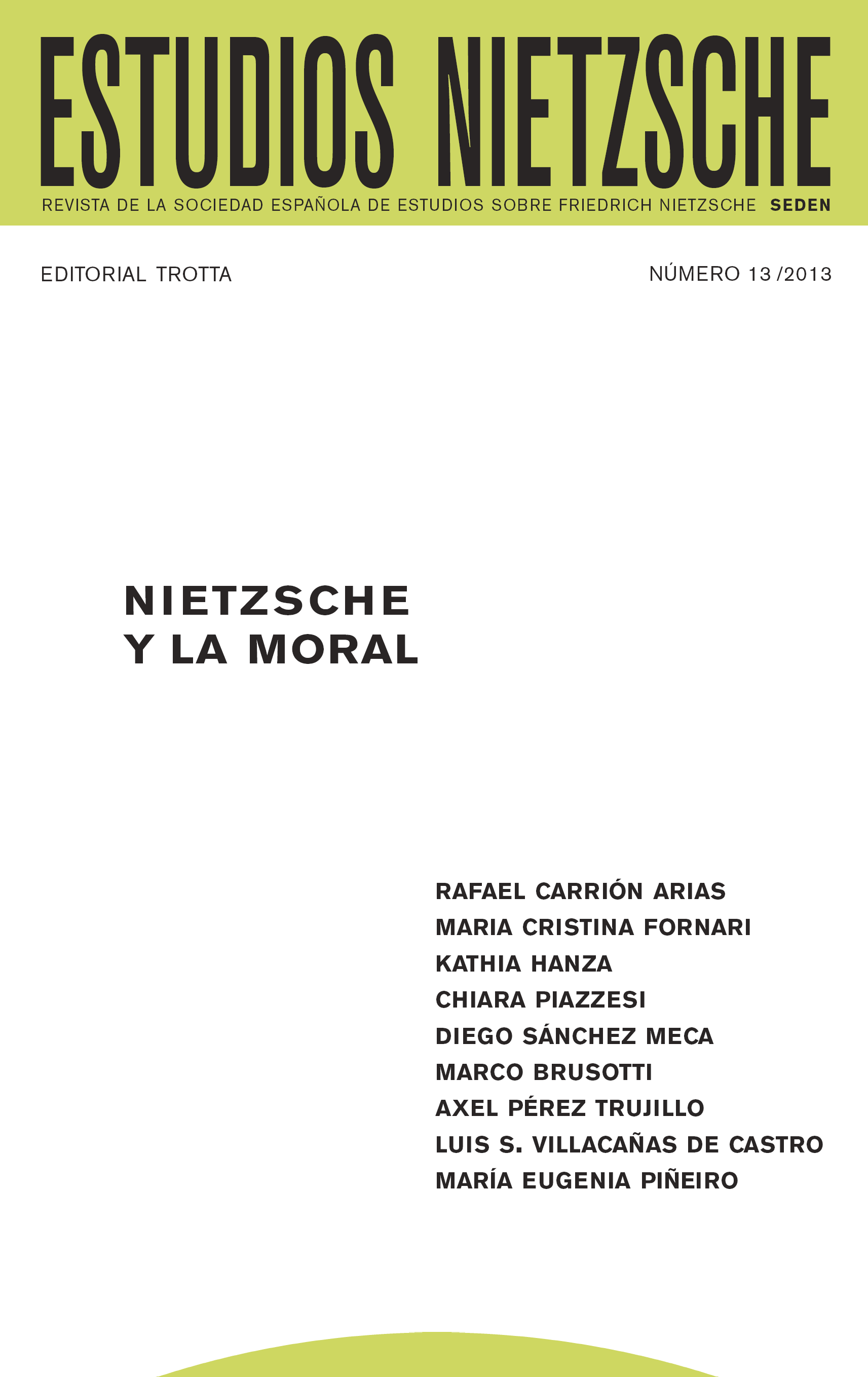Tension: Figures and Concept in Nietzsche’s Thought
DOI:
https://doi.org/10.24310/EstudiosNIETen.vi13.10697Keywords:
Nietzsche, distension, greatness, Pascal, Marcus AureliusAbstract
Up to now critics have been neglecting the importance the concept of «tension» (Spannung) has for Nietzsche. The complex semantic field with its innumerable synonyms and antonyms displays a remarkable polysemy. (In the natural sciences the word ‘tension’ stands for a series of concepts which although precise are very different from each other, like electric and mechanic tension.) The study of this semantic field is therefore of interest for both the history of concepts and the history of metaphors. Nietzsche’s cultural
references go from the classics of western philosophy (Heraclitus, Marcus Aurelius) to contemporary psychology and physiology. In his texts multifarious metaphors intertwine and overlap. They stand for very different models (the bow, the tempest, the explosion etc.), whose various connections and interferences the paper reconstructs. The different, positive and negative, connotations of tension are analyzed as well as Nietzsche’s attempt to link to this concept a change of viewpoint. We follow his reflections on classical topics in ethics (the criticism of stoic morals) as well as in aesthetics (the beautiful and the sublime). Particular attention is paid to the complex connection between the concept of «tension» and the concept of «greatness».
Downloads
Metrics
References
Brusotti, M., «Kern und Schale. Wissenschaft und Untergang der Religion bei Nietzsche», en C. Gentili y C. Nielsen, Der Tod Gottes und die Wissenschaft. Zur Wissenschaftskritik Nietzsches, Berlin/New York: W. de Gruyter, 2010, pp. 67-81.
Campioni, G., Les lectures françaises de Nietzsche, Paris: PUF, 2001.
Joly, H., Psychologie des grands hommes, Paris: Edition SPES, 1883.
Mainberger, S., «Spannung II», en J. Ritter – K. Gründer (eds.), Historisches Wörterbuch der Philosophie, Vol. 9, Basel/Stuttgart, 1971 ss., pp. 1284-1290.
Brusotti, M., Die Leidenschaft der Erkenntnis. Philosophie und ästhetische Lebensgestaltung bei Nietzsche von Morgenröthe bis Also sprach Zarathustra, Berlin/New York: W. de Gruyter, 1997.
Müller-Lauter, W., Nietzsche. Seine Philosophie der Gegensätze und die Gegensätze seiner Philosophie, Berlin/New York: W. de Gruyter, 1971.
Müller-Lauter, W., Über Freiheit und Chaos. Nietzsche-Interpretationen II, Berlin/New York: W. de Gruyter, 1999
Nietzsche, F., Obras Completas, I-IV (OC ). Director ed. Diego Sánchez Meca. Madrid: Tecnos, 2011-2016
Nietzsche, F., Correspondencia I-VI. (CO). Director ed. Luis E. de Santiago Guervós. Madrid : Trotta, 2005- 2012.
Nietzsche, F., Fragmentos Póstumos I-IV (FP). Director ed. Diego Sánchez Meca. Madrid: Tecnos, 2006-2010.
Volz, P. D., Nietzsche im Labyrinth seiner Krankheit. Eine medizinisch-biographische Untersuchung, Würzburg: 1990.
Downloads
Published
How to Cite
Issue
Section
License
As of issue 21 (2021) this journal is published only in open access (diamond route).
From that number 21, like the previous numbers published in NIETZSCHE STUDIES, they are subject to the Creative Commons Acknowledgment-NoComercia-ShareIgual 4.0 license, the full text of which can be consulted at <http://creativecommons.org/licenses/by-nc-sa/4.0 >
It is the responsibility of the authors to obtain the necessary permissions of the images that are subject to copyright.
This work is licensed under a Creative Commons Attribution-NonCommercial-ShareAlike 4.0 International License.
Copyright generates two different rights: moral rights and patrimonial rights that EJFB recognizes and respects. Moral rights are those relating to the recognition of the authorship. They are rights of a personal nature that are perpetual, inalienable, unseizable and imprescriptible as consequence of the indivisible union of the author and his/her work.
Patrimonial rights are those that can be derived from the reproduction, distribution, adaptation or communication of the work, among others.







11.png)
